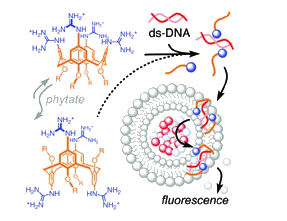- Takeuchi, T.; Bagnacani, V.; Sansone, F.; Matile, S. “Amphiphilic Counterion Activators for DNA: Stimuli-Responsive Cation Transporters and Biosensors in Bulk and Lipid Bilayer Membranes” ChemBioChem 2009, 10, 2793-2799

We report that amphiphilic counterions can enable DNA to act as cation carrier, enzyme detector and biosensor. Calf thymus DNA is used as example throughout the study. Evaluation of a series of counterion activators suggests that strong amphiphilicity, alkyl or calix[4]arene tails and guanidinium cations give best results, whereas weak amphiphilicity, bola-amphiphilicity, planar aryl tails and ammonium cations are less satisfactory for various reasons. In the U-tube, DNA-counterion complexes can carry cations such as safranin O or p-xylene-bis-pyridinium bromide (DPX) across bulk chloroform membranes, whereas anions such as carboxyfluorescein (CF) and (8-Hydroxy-1,3,6-pyrenetrisulfonate (HPTS) are not transported. Uptake of DNA-counterion complexes into intact vesicles is demonstrated by DNA trapping experiments with internal polylysine. Comparison of results from different assays suggests that DNA-counterion complexes act as cation carriers under mild conditions, whereas pore formation and lysis dominate at higher concentrations. Applicability of DNA-counterion transporters for the detection of enzyme activity is demonstrated with phytate as an inactivating substrate and phytase as a reactivating enzyme. Compatibility with biosensing is exemplified with the fluorometric monitoring of phytate levels in almond extracts. The conceptual significance of these findings is briefly discussed, as are promising perspectives such as the application of DNA chemistry to multianalyte sensing in fluorogenic vesicles.
open archive unige:7939 • pdf ![]()
